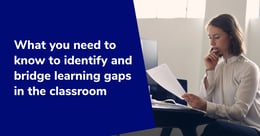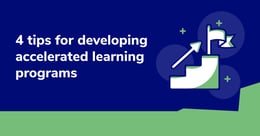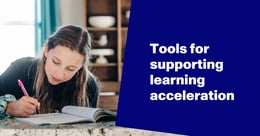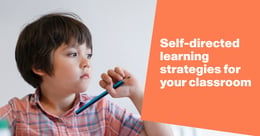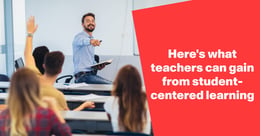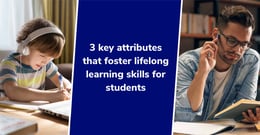
Addressing unfinished learning: 5 common myths, debunked
In the effort to ensure that all students are able to reach their full potential, it can be easy to lose sight of the fact that learning is a profoundly individual experience.
As we look for effective strategies to identify and address unfinished learning, we need to stay mindful of persistent myths that surround the topic. By understanding where the conventional wisdom may fall short, we can stay focused on research-backed techniques like accelerated learning, further ensuring that students receive the individualized support they need to become lifelong learners.
Here, we’ll explore five common myths about unfinished learning, and we’ll peel back persistent misconceptions to help learners secure the assistance they need.
Myth 1: ‘Unfinished learning’ is just a euphemism for ‘learning loss’
Language is always in flux. As we continue to grapple with the legacy of COVID-19 on our education system, the terms we use to describe students’ academic performance have evolved.
Although the term “learning loss” has not been completely retired from the popular lexicon, many experts have begun to lean more heavily on the term “unfinished learning” to describe the situation in which a large number of schools and districts find themselves today.
However, this is more than just a matter of semantics: Reframing the challenge we face as a matter of interruption—rather than a deficit—sets the stage for the pursuit of aspirational remedies.
How is unfinished learning different from learning loss?
A working learning loss definition from a glossary of education terms describes the phenomenon as “any specific or general loss of knowledge and skills” or “reversals in academic progress, most commonly due to extended gaps or discontinuities in a student’s education.” Summer learning loss is one frequently discussed example of this kind of phenomenon, with summer break representing a discontinuity in the school year.
The definition of learning loss refers to reversals and emphasizes what's lacking. Conversely, the phrase “unfinished learning” acknowledges that disruptions and impediments don’t necessarily make learning retreat, and forward motion will always proceed from the student’s current state of understanding.
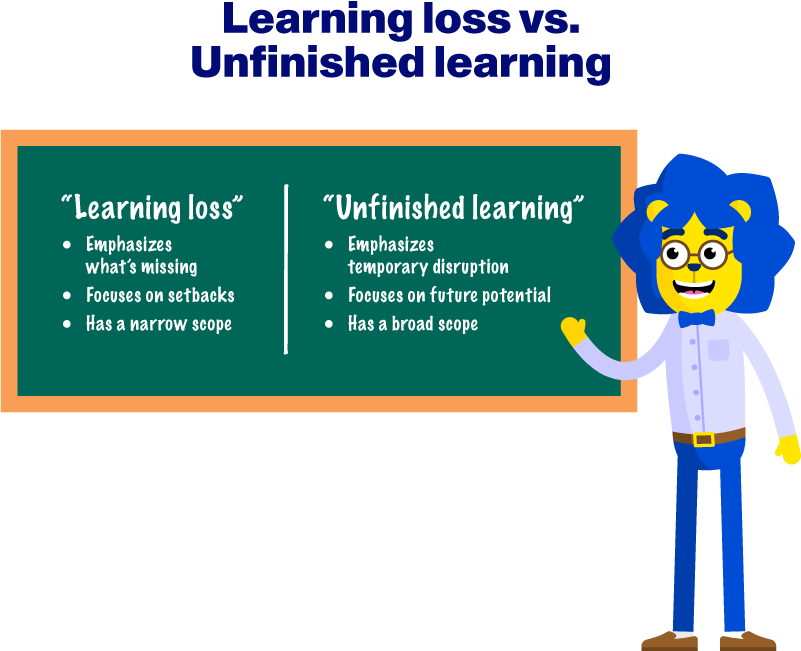 In a sense, all learning is unfinished because lifelong learners maintain a level of curiosity and interest that will carry them toward new questions that have yet to be answered. Many commentators have also pointed out that learners were forced to quickly adapt to previously unfamiliar modes of instruction during the pandemic. As a result, many of these students learned new ways of interacting with the world and gained resiliencies that previous generations haven’t experienced. At the same time, many students lost a great deal outside of their education.
In a sense, all learning is unfinished because lifelong learners maintain a level of curiosity and interest that will carry them toward new questions that have yet to be answered. Many commentators have also pointed out that learners were forced to quickly adapt to previously unfamiliar modes of instruction during the pandemic. As a result, many of these students learned new ways of interacting with the world and gained resiliencies that previous generations haven’t experienced. At the same time, many students lost a great deal outside of their education.
When we shift the conversation toward the notion of unfinished learning, we acknowledge the difficulties that have mounted for our students while also honoring their persistence, perseverance, and potential.
Myth 2: Unfinished learning looks the same for all students
Students at every stage of the K-12 educational journey have experienced disruption, and initial research seems to indicate that unfinished learning may have a pronounced effect on learners across grade levels. However, more research is needed to determine exactly how the causes and effects of learning disruption played out for students in different grade levels.
Preliminary findings point toward a sizable impact overall, with significant variability. Fall 2021 reporting on math and reading scores from Education Week explored the results of a Curriculum Associates study. The article pointed to some noteworthy trends.
- From first through eighth grade, researchers found that student performance in math and reading largely lagged behind pre-pandemic levels.
- The impact on student performance varied based on the subject and grade level in question.
- The impact of unfinished learning that took place during pandemic-related disruptions may further compound preexisting achievement gaps.
“The pandemic has affected all students, but not in the same way or the same degree,” said Curriculum Associates’ Kristen Huff, according to Education Week.
Likewise, social and emotional challenges may have had a more acute impact on the academic performance of students in later grades compared to their younger peers. Among public high school teachers whose students did not perform as well as in pre-pandemic years, a United States Government Accountability Office survey on pandemic learning found that 92% said social and emotional issues played a part. For teachers with students in third through eighth grade, that number was 83%, and for younger students, it was 69%.
Myth 3: Remediation is always the best way to address unfinished learning
Traditional remediation focuses on addressing unfinished learning by zeroing in on topics from the previous grade level. In essence, students are encouraged to complete the unfinished elements of their previous grade before moving on to new targets associated with the next grade level.
Although this approach could be suitable for building prerequisite skills in certain circumstances, learning acceleration may often be preferable. Acceleration doesn’t suffer from some of the drawbacks associated with traditional remediation, such as disengagement or lost time and effort expended on concepts the student may already have grasped.
What is the difference between acceleration and remediation?
Compared to remediation, accelerated learning keeps students focused on what’s next. Teachers help learners explore grade-level content while identifying and addressing students' specific learning gaps as necessary. This flexible technique can be a suitable way to meaningfully engage students and keep them on pace instead of halting them in their tracks. That doesn’t mean learning acceleration is always easy, especially at scale. But in many cases, the benefits may be significant.
Myth 4: Unfinished learning is just about math and reading
Although literacy and math tend to absorb much of the focus in the conversation around unfinished learning, other subjects have also likely been impacted by pandemic-related disruptions.
For example, guidance from the Rhode Island Department of Education on how to address unfinished learning in social studies acknowledges that progress in the discipline is not dependent on a neatly linear path: In other words, the ability to learn a new skill isn’t necessarily predicated on previously acquired knowledge. However, the guide does note that unfinished learning is a problem in social studies and that the rush to prioritize acceleration in other subjects could come at the expense of support for helping students grow in social studies domains.
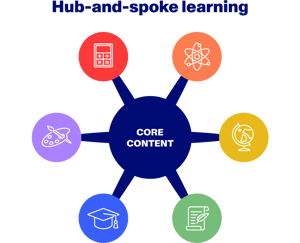 Effectively planned project-based learning that ties together multiple content areas could help ensure that subjects such as science and social studies are still prioritized alongside math and literacy. For example, a McKinsey article on COVID-19 and education highlighted how one district employed a hub-and-spoke strategy where learners split their time between core content and relevant enrichment. It may take time to discover new modes of learning that weave subject areas together, but getting it right could help improve student engagement.
Effectively planned project-based learning that ties together multiple content areas could help ensure that subjects such as science and social studies are still prioritized alongside math and literacy. For example, a McKinsey article on COVID-19 and education highlighted how one district employed a hub-and-spoke strategy where learners split their time between core content and relevant enrichment. It may take time to discover new modes of learning that weave subject areas together, but getting it right could help improve student engagement.
Myth 5: Academics should be the sole focus of initiatives that address unfinished learning
Education doesn’t happen in a vacuum. Students bring their whole selves to school, and the learning environment should be set up to support all of their needs—not just the needs that are directly related to core content.
In fact, best practices on learning acceleration from the Louisiana Department of Education clearly state that student well-being, including mental health, is vital for academic success.
“Students are much less likely to learn math, reading, [and] critical thinking when they feel insecure, overwhelmed, or stressed,” the report notes.
As such, it’s vital that schools focus on strategies for inspiring learners and teachers. The educational environment should promote positive social connections among peers and between students and staff.
Keep in mind that though unfinished learning is a large-scale phenomenon, every student is unique—and so are their needs. This also extends to academic support. As a strategy, learning acceleration requires that each student has the assistance they need for closing their specific learning gaps. Individualized help—like the unlimited on-demand tutoring from Paper that’s available 24/7—can help students reach their full potential.
From myth to reality: Taking on unfinished learning
Unfinished learning is a pervasive challenge, but today’s students have demonstrated fierce resilience in the face of monumental obstacles. As our schools strive to support these students on the road to academic and personal success, they’ll need to ensure that they provide the broad-based assistance students need to thrive in every subject and throughout their academic journeys while recognizing that each learner is unique.
Accelerated learning can be an indispensable tool as schools seek to address the profound disruptions today’s students face. Check out our K-12 guide to learning acceleration for more information.

